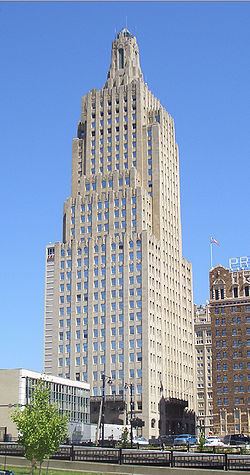Status Complete Height 145 m Floors 34 | Owner NorthPoint Development Opened 1931 Construction started 1930 | |
 | ||
Alternative names KCP&L BuildingPower and Light Building Type Commercial offices originally, now luxury apartments and upscale event space Location 1330 Baltimore AveKansas CityMO 64105United States Completed 1931; 86 years ago (1931) Architects Henry F. Hoit, Edwin M. Price Similar One Kansas City Place, St Mary's Episcopal Church, Epperson House, Sheraton Kansas City Hotel, Rotary Park | ||
The Kansas City Power and Light Building (also called the KCP&L Building and the Power and Light Building) is a landmark skyscraper located in Downtown Kansas City, Missouri. The building was constructed by Kansas City Power and Light in 1931, as a way to promote new jobs in Downtown Kansas City. Since then, the Art Deco structure has been a prominent part of the Kansas City skyline. The east side of the building faces the Power & Light District which bears its name, and the building's iconic lantern appears on promotional materials and signage for the district and even Kansas City as a whole.
Contents
- Map of Kansas City Power and Light Building 106 W 14th St Kansas City MO 64105 USA
- History
- Lighting
- References
Map of Kansas City Power and Light Building, 106 W 14th St, Kansas City, MO 64105, USA
History
The building was designed by the Kansas City architecture firm of Hoit, Price and Barnes, which also designed Municipal Auditorium and 909 Walnut. Rumor for years said the original plans included a twin building to be paired on the immediate west side of the building, but the second tower was never built due to the effects of the Great Depression on local real estate prices. This was debunked in 2013 by local architect Dan Hicks who reviewed plans and interviewed Clarence Kivett, a well known architect working for Hoit, Price and Barnes at the time of the building design. The west side of the building has no windows because it was meant to be a firewall next to any building built next to it, plus the elevator shafts are along that side of the building.. The Power and Light Building, at 34 stories, was Missouri's tallest habitable structure from 1931 until the completion of One U.S. Bank Plaza in St. Louis in 1976. The building remains the tallest residential building in the State of Missouri.
Kansas City Power & Light Co. left the building in 1991.
In 2010 Kansas City selected the area adjacent to the Power and Light Building as a potential location for a hotel and convention center, to fulfill a need for the city. However, the city only received two proposals from property developers for a convention hotel at the site. The city considered the two proposals it received in 2011 as lackluster and were considering reopening the bidding process for a different downtown location.
The building lost its last tenant, BNIM, a Kansas City-based architecture and planning firm, on September 2, 2014. The 36-story Power & Light building began a conversion into an apartment tower in October 2014. The project, led by NorthPoint Development of Riverside, which has now been completed includes 217 apartments in the historic tower, with an additional 82 units constructed wrapping around and built above a new 500 stall parking garage serving the building. The building lobby was converted into a premier event space holding up to 500 guests.
Lighting
The Kansas City Power and Light Building is crowned by an ornate Art Deco lantern, which features prismatic glass panels concealing red-orange lights that glow each evening at sunset. Originally, each recessed setback of the building also held multicolor flickering flood lights that dazzled nighttime viewers with the impression of blazing flames. Today, LED floodlights rotate through an abundance of colors and dazzle onlookers.
